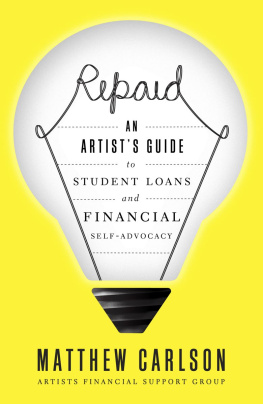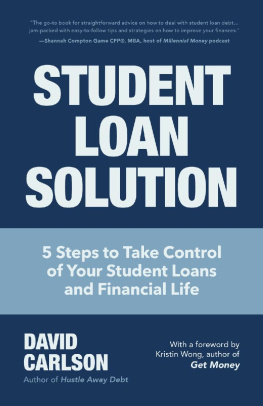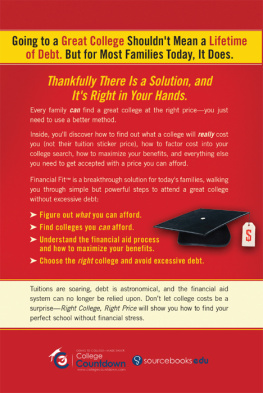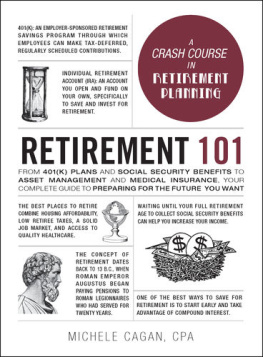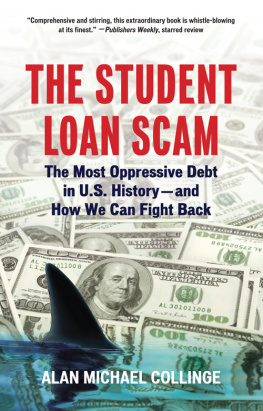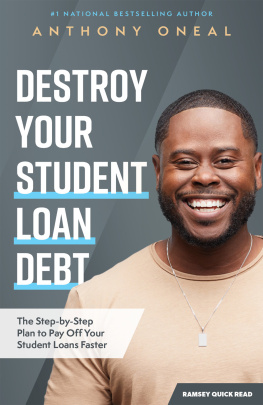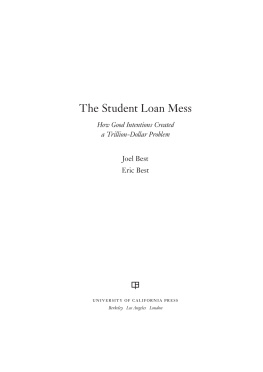for he owes not any man.
Introduction
Where Do I Start?
You might be skeptical. If you are in your last year of an undergraduate or graduate training program and the faculty made you buy this book, you might think: Why do I need to learn about student loans and budgeting? Ill never need a day job, success will come early, and everything will fall into place. Or you might be desperate. If you are a working artist several years out of school and are quickly browsing through these pages, you might think: What can this book possibly tell me that will stop the calls from debt collection agencies? I cant afford to be an artist, success will never come, and everything is falling apart.
Young artists are often given contradictory advice. Parents will warn you about the impossible financial struggle ahead, because they want to spare you the stress of being a starving artist. Teachers will tell you that talent always rises to the top, because they want to encourage you and your art. Well, lets clear this up right away: neither advice is true. The financial life of an artist is erratic and frustrating, but not impossible. And the most talented person doesnt always get the job. The truth is not necessarily easy to hear. We plan on telling you the truth, as best we can.
The Artists Financial Support Group (AFSG) is an organization of early-career working artists who believe that a financially savvy artist is a better artist. We promote financial self-advocacy , an assertion of self-determination and personal responsibility in your financial life. The knowledge we will share with you is practical, not theoretical; it comes from actually living the life of an artist. We attempt to confront the unique financial concerns of artists with innovative and sensible solutions. Since 2011, we have led workshops at the NYU Graduate Acting Program, Yale School of Drama, Julliard, the Actors Fund, and the SAG Foundation. The goal of this book is simple: to share everything we wished someone had told us before we finished school, tangible information about the financial lives of working artists. Nevertheless, you should use financial self-advocacy to research further information on your own. The topics covered in this book have a tendency to change rapidly, and it is your responsibility to learn the details and make informed decisions. We hope to empower you to take personal responsibility for your financial life. We can give you advice, but the decisions are ultimately yours.
A major focus of this book is student loans. If you are a current student or recent graduate, youve probably paid a considerable amount of money for a degree in the arts. Unfortunately, we may have reached the point where the cost of an arts education outweighs its value. According to the Wall Street Journal , student loan debt in America surpassed $1 trillion in 2012, surpassing even our national credit card debt. Forbes reported a college tuition increase of 498% from 1985 to 2011 (more than four times the inflation rate for the U.S. dollar during the same period) while data from the Department of Education reflects that the number of students graduating with degrees in the visual and performing arts more than doubled. The price of education skyrocketed just as the number of aspiring artists exploded, leaving graduates with a staggering amount of debt and an extraordinarily competitive job market.
Throughout this book we will use an example of a consolidated student loan for $100,000. This may seem like an unrealistically large number, but graduates of elite artistic training programs will tell you that it is unfortunately quite real. How do you negotiate exorbitant student loan payments on an erratic income? How do you plan to buy a house or have children? Even for successful working artists, student debt can seem insurmountable compared to their income. The challenges we face leave young artists feeling isolated, without hope, and perhaps worse, without art.
This is why you should read Repaid: An Artists Guide to Student Loans And Financial Self-Advocacy. The success of an artist requires more than talent and perseverance: it requires a strong education in personal finance. You cannot wait for extraordinary success - the series regular job on television or the sale of your paintings at a New York gallery. Whether youre a writer, painter, dancer, actor, composer, singer, designer, director, or artist of any medium, you are capable of taking control of your finances. With self-discipline, a freelancers tenacity, and an artists creativity, a career in the arts is possible. You will repay your loans. But it cant be done without taking ownership of your financial education and responsibility for your financial life.
A brief disclaimer: we are artists, not bankers. Read this advice from your peers and then educate yourself about your specific circumstances. Recognize that youre not alone and that debt is a shared experience. Turn the page and take the next step toward financial self-advocacy.
The Artists Financial Support Group
Freddy Arsenault, Matthew Carlson,
Ben Graney, & Timothy Sekk
Identification
How Do Student Loans Work?
So youve finished school. Youre in debt. Youve probably received mail already from both the government and your private lenders (if you have them). You know you should do something about it, but its much easier to ignore them, to put the letters in a pile of things to do later, or to throw them into the trash unopened. Though these might seem like easier ways to deal with your debt, believe us, theyre not. Better to be informed and figure out what your options are, learn what loans you have, and start to take action. Lets take a look at what you need to know, and make that pile of envelopes a little less terrifying.
The following information will help you identify which loans you have, what interest has been accruing, and what exactly has been happening while youve been in school. Well address consolidation in a later section, but for now, lets just explain what it is you are actually looking at when you first open that envelope on your desk. No need to panic, just take a deep breath. Well walk you through what you need to know.
The Basics About Loans
Even the language of finance is intimidating, especially for artists. Maybe you didnt do so well in high school economics, or maybe its been a few years. If you dont immediately understand your loan statements, know this: You are not stupid. The convenience of credit allows borrowers to sign without really knowing the details. However if you know the basics and learn the lingo, you will feel much more in control. Lets take a look at a simple example loan and start to get familiar with what the financial language means. As an example, lets borrow five thousand (hypothetical) dollars from the bank and look at how loans work.
The principal of a loan refers to the base amount owed: the initial amount borrowed when you first take out a loan. In our example, the principal is $5,000. An interest rate is the fee a bank charges you for borrowing money, calculated as a percentage of the original loan amount. The fee is calculated annually, and therefore is often referred to as an annual percentage rate or APR . Lets say that we have an APR of 10% for our example loan of $5,000, and that the interest rate is fixed. A fixed interest rate is a percentage-based fee that remains the same throughout the life of the loan. So how does it work? The first year you take out the loan, the interest will be:

